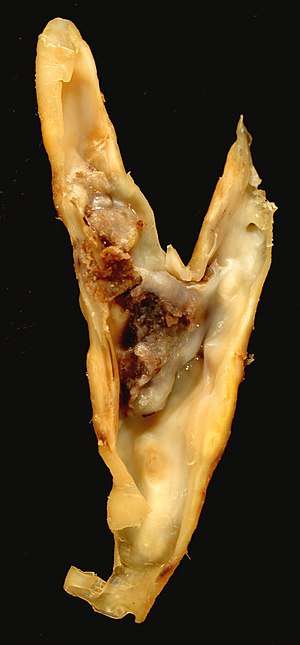Endarterectomy
Endarterectomy is a surgical procedure to remove the atheromatous plaque material, or blockage, in the lining of an artery constricted by the buildup of deposits. It is carried out by separating the plaque from the arterial wall.
| Endarterectomy | |
|---|---|
 Endarterectomy- plaque removal by surgical excision and closure | |
| ICD-9-CM | 38.1 |
| MeSH | D004691 |
It was first performed on a subsartorial artery in 1946 by a Portuguese surgeon, João Cid dos Santos, at the University of Lisbon. In 1951, E. J. Wylie, an American, performed it on the abdominal aorta. The first successful reconstruction of the carotid artery was performed by Carrea, Molins, and Murphy in Argentina, later in the same year.[1]
An endarterectomy of the carotid artery in the neck is recommended to reduce the risk of stroke when the carotid artery is severely narrowed, particularly after a stroke to reduce the risk of additional strokes.
A femoral endarterectomy is also frequently used as a supplement to a vein bypass graft at the sites of surgical anastomosis. Pulmonary hypertension caused by chronic thromboembolic disease (CTEPH) may be amenable to pulmonary thromboendarterectomy of the pulmonary artery. This is a highly specialized procedure.
Additional images

References
- Thompson, Jesse E. (1996). "The Evolution of Surgery for the Treatment and Prevention of Stroke". Stroke. 27 (8): 1427–1434. doi:10.1161/01.STR.27.8.1427. PMID 8711815.
External links

- Endarterectomy at the US National Library of Medicine Medical Subject Headings (MeSH)